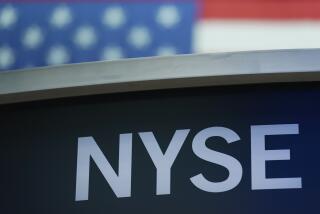Fed, Banks Help Slow Rise of Dollar Overseas
- Share via
LONDON — Concerted intervention by the U.S. Federal Reserve and several European central banks succeeded in knocking down the dollar in active trading today.
But the market’s short-term bullish sentiment still helped the currency bounce up from its session lows.
Gold prices were down.
Currency dealers said the first orchestrated intervention of the year, with moderate participation by the Fed, the West German Bundesbank and the central banks of Britain, Switzerland, Italy, Belgium and the Netherlands, added a note of caution to trading.
But they said it didn’t stop the market from testing higher levels again.
“The intervention wasn’t enough to completely dent the dollar’s ambitions,” said Nigel Green, assistant foreign exchange director at EBC Amro Bank. “The market is likely to play a cat and mouse game with the central banks for the next few days.”
Strong U.S. interest rates and technical factors have been helping the dollar in recent weeks, although one trader said the overall long-term outlook was somewhat bearish.
“The outlook will be bearish until we see or hear some very positive news on the U.S. trade and budget front,” he said, referring to the twin deficits.
In Tokyo, where trading ends before Europe’s business day begins, the dollar rose 1.25 yen to a closing 126.95 yen. Later, in London, it was quoted at 126.15 yen.
The dollar fell against the British pound in London. Sterling fetched $1.7815, up from $1.7643 Tuesday.
Gold fell in London to a late bid price of $403.50 an ounce, compared with $404.75 bid late Tuesday. In Zurich, gold closed at $403.30 an ounce, up from $405.10.
Earlier, in Hong Kong, gold fell $2.70 to close at a bid $404.48.
More to Read
Inside the business of entertainment
The Wide Shot brings you news, analysis and insights on everything from streaming wars to production — and what it all means for the future.
You may occasionally receive promotional content from the Los Angeles Times.










